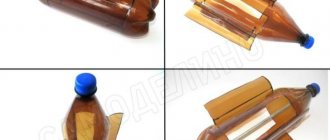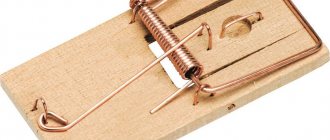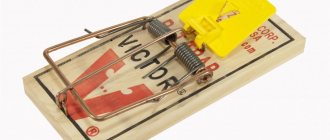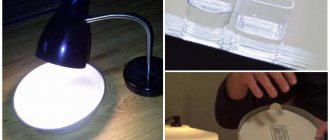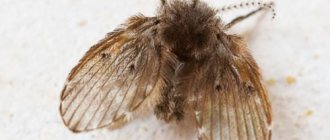With the arrival of autumn cold weather, mice begin to actively move from summer areas to human houses and apartments. Every year we have to contain the rodent infestation and look for more and more effective methods of control. There are only two ways to defeat the invasion of mice that have settled in your house or garage - get a cat or regularly install mousetraps. The bigger, the better. The easiest way is to make a mousetrap from a plastic bottle with your own hands. Costs are minimal, especially since there is plenty of material for traps. If you guess the design of a mousetrap made from a plastic bottle, then you can end the problem quickly enough.
Which trap to choose
At first glance, the easiest way is to buy a ready-made mousetrap or make a similar design with your own hands. But this is only at first glance. A mouse, like a rat, has considerable intelligence, learns quickly and remembers well how to bypass mousetraps. Therefore, it will be useful to periodically replace old plastic bottle mousetraps with new, more effective and efficient designs.
Most often, several of the most popular designs are used to combat domestic rodents:
- Petal mousetrap, it can be made in a couple of minutes, there is a considerable risk that the mouse may escape from the trap before it is reached;
- Falling mousetrap, if you make a structure from a plastic bottle exactly as described, then the effective operation of the device is guaranteed;
- A mousetrap is a rocking chair, the most difficult to make, but also the most effective. It can be done in several ways, the main thing is to follow the principle of operation. Such mousetraps can operate reliably for many years without any major complaints.
Advice! Don't underestimate the ability of mice to escape traps. You need to check traps as often as possible, since according to statistics, approximately half of the rodents successfully escape from the trap.
You can get an idea of the capabilities of mouse balancing act and understand how to make a mousetrap from a plastic bottle from the video
What can you put in a trap?
Rodents can eat almost anything. But they especially prefer the following delicacies:
- The aroma of smoked lard attracts rodents. Even a small piece will tempt the rodent and he will rush to this smell;
- Parasites will not bypass sunflower oil, especially unrefined oil. When you fry something on it, the aroma will spread throughout the house - such bait will attract them with lightning speed;
- bread and roll with sunflower oil;
- fried sunflower seeds;
- smoked sausage.
What you need to know before making a bottle mousetrap
First of all, you should not count on the absolute effectiveness of a mousetrap; even the most successful and effective, at first glance, trap can malfunction, so it will be useful to observe how the mouse falls into the trap and, most importantly, how it tries to get out of it. Such observations can be very useful when it comes time to make a new, more cunning mousetrap.
When planning the design of a mousetrap, there are three factors to consider:
- The plastic bottles from which the traps are made must be changed at least once a month;
- Poisons and toxic substances must not be used in mousetraps;
- The labor intensity of making a mousetrap from a plastic bottle should be minimal, otherwise this activity will quickly get boring.
The mouse has the ability to capture the most subtle odors. If a dozen mice are caught in a mousetrap, then odors with “signals” of panic will definitely remain on the plastic bottle. Such mousetraps should be thrown away without regret, and a new trap can be made to replace the old one.
The material of a plastic bottle does not pose a particular barrier for a rodent, so it is important not only to catch, but also to get the mouse out of the trap in time, before the animal simply gnaws a hole and runs away with the bait.
How to catch a mouse without a mousetrap (humane methods)
Living in a cat's house is guaranteed to get rid of gray invaders. But this is not suitable for all people: some do not like pets, others are allergic to them.
The use of mousetraps and chemicals is also not always acceptable. The sight of a lifeless body can frighten children. And if the animal dies in a place where it will be difficult to get it from, then the unpleasant smell and insects will annoy the residents for a long time.
Plastic bottle traps
It is very easy to catch a mouse using a device made from a plastic bottle. Unrefined vegetable oil is poured into it so that it covers the entire inner surface of the container. The cut neck is placed on a stack of books with an inclination of 40 degrees.
The rodent, sensing a delicious smell, will crawl into the bottle, but will not be able to get out of it on its own; its paws will slide along the surface.
Glass jar trap
You can catch a mouse without a mousetrap using a half-liter glass jar. A piece of sausage is stuck to its wall. One edge of the container is placed on the edge of a ten-ruble coin, and the other on the floor. The animal will try to get to the food and will definitely drop the jar.
Fishing with a bucket
You can catch a mouse at home in any bucket. An awl is used to poke holes in the bottom and cap of a plastic bottle. A knitting needle or rigid wire is inserted into them. The container is attached to the top of a bucket half filled with water. Smoked fish is placed in the bottle. And a board is placed against the bucket, along which the wild animal will climb up. Then, the bottle will begin to make its way to the bait. Unable to stay on the container, the mouse will fall into the water.
Video:
Tin Can Trap
Catching is carried out using tin containers. A hole the size of a coin is made in its wall with the teeth inward. Raw or salted lard is placed in a tin can. Once in the container, the rodent will not be able to get out.
Ultrasonic repellers
If a person does not have the time and desire to make devices in order to catch gray invaders, it is worth buying an ultrasonic device. It will perfectly help fight the invasion of uninvited guests. The device is a humane method of getting rid of mice, that is, it does not harm them.
Waves of a certain length cause panic attacks in wild animals. They escape from the house where the ultrasound device is located.
Before purchasing a repeller, you need to consider the following questions:
- Cheap devices are equipped with the “Ultrasound Frequency Adjustment” function, which will need to be carried out by the person himself. For advanced models, frequency changes are performed automatically. It is worth deciding which mechanism is preferable.
- To protect a small apartment, one not very powerful device is enough. And for a mansion or large country house you need to buy 2-4 devices.
- In the store, read the instructions and find out all the technical characteristics of the device you are purchasing. Each model has a specific range that guarantees trouble-free operation. If the repeller needs to be placed in the cellar, it is determined whether it will work at low temperatures and high humidity.
- Budget devices most likely have a short service life and do not always function well.
Standing in front of the counter, a person must determine what is more important for him - to buy a low-power device and save money, or, conversely, to buy a high-quality, but expensive device.
Options for the most successful mousetraps
All of the mousetrap designs below do not require special skills or tools and can be made, as they say, “on the knee” in a few minutes. To build a trap you use:
- Scotch tape and adhesive tape, nylon threads;
- Plastic bottles with a capacity of 2 and 3 liters;
- Scissors or stationery knife;
- Bait.
Advice! A piece of salted lard, fried seeds and a walnut kernel work reliably as bait.
Oddly enough, cheese or sausage are significantly inferior in effectiveness to lard; such bait quickly dries out and loses its attractiveness.
Make an effective bottle mousetrap in 60 seconds
A simple and quite effective mousetrap can be made from an ordinary three-liter plastic bottle. We use a nut kernel as bait. The full course on how to make a mousetrap from a plastic bottle is shown in the video
Initially, you will need to make a mount for the bait from two loops of nylon thread.
Using a utility knife, make a cut on the wall so that you get a petal covering a small window. The window size should be no more than 20 mm. Due to its rounded shape, the petal should easily bend inside the plastic bottle and not deviate outward, preventing the mouse from getting out of the trap.
We pierce the side walls of the bottle on both sides, stretch the thread with the bait and fix the suspension in a taut state using matches and tape.
The place for hanging the bait can be chosen at a height of at least 10-12 cm from the bottom, this is enough for an ordinary mouse, sometimes rodents demonstrate miracles of jumping ability, so the design of the trap can be supplemented with another bottle, which will catch everyone who covets the bait.
The simplest mousetrap options
The simplest version of a mousetrap made from a plastic bottle is shown in the video
You can make a simple device with your own hands in a few seconds. You only need to cut off the neck and cut the edge of the remaining container with scissors in the form of triangular teeth, 30-35 mm long.
The jagged edges are folded into the bottle, and the bait is placed on the bottom of the trap. According to the creators' plan, the mouse gets inside the mousetrap, but will not be able to get out of it because of the teeth.
A more effective version of a mousetrap can be made from a plastic container according to the diagram below.
You need to cut off the top of the bottle, turn it over, remove the cap and put it back into the cut part. The result is a design reminiscent of an old non-spill inkwell.
It is recommended to treat the inside of the mousetrap with sunflower oil, and the installed upper part of the trap will need to be fixed with a stapler.
A good falling mousetrap can be made from an ordinary plastic bottle with a window cut out in the neck area. Bait is placed at the bottom of the bottle, and the trap itself is tied with a cord around the neck and placed on the table.
To trigger the mousetrap, it is placed on the edge so that the bottom part with the bait is behind the edge of the tabletop. The mouse, having climbed into the bottle, upsets the balance, which leads to the container tipping over and hanging on the cord.
Getting out of the mouse container is quite difficult. It will be necessary to remove it from the trap in time before the cat steals it along with the trap.
Engineering solution
You can make an even simpler mousetrap from a bottle with your own hands by cutting off the bottom part of the container, making teeth from the walls and bending them inward (a tin can will do). There are also more complex solutions. This is not only a dacha-village option, it is also quite suitable for a city apartment.
It is done and applied like this:
- The neck of the container must be cut off and a hole must be pierced at the very top.
- Thread the cord into the hole and secure it with a knot. The second end must be tied to the top of the table leg or secured in any other way.
A bottle mousetrap is distinguished by its humane nature, as it does not harm the rodent.- The homemade trap with bait now needs to be placed on the edge of the table so that part of it hangs above the floor.
- The result will not be long in coming: as soon as the rodent climbs inside and tries to get to the food, the bottle will fall and hang on the rope. The length of the cord must be calculated so that the homemade item remains hanging freely, and does not stand on the floor or touch the edge of the tabletop, otherwise the prisoner can get out.
Homemade mousetraps made from a plastic bottle are also good because they are economical - the materials for them are always available, and you don’t have to spend money on them. In addition, the animals remain alive and can then be released into the wild away from home. It would be a good idea to wear rubber gloves: mice are carriers of various infections.
How to make a mousetrap - a rocking chair
The most perfect mouse trap can be made using the principle of a swing or a pendulum. The principle of operation of the mousetrap is in many ways similar to the previous version of the trap, the only difference being that the bottle does not tip over from the table, but tilts under the weight of the mouse, blocking the exit from the trap.
The typical design of the device is shown in the photo. The principle of operation can be seen in more detail in the video.
In order to make a trap, you will need a 1.5 liter bottle, preferably with a long and narrow neck. Since the mousetrap must swing freely under the weight of the animal, you will first need to determine the line on which the center of gravity is located. To do this, you can place an ordinary faceted pencil on the table and a container on it. Moving the bottle left and right, we find the equilibrium position and mark the line with a marker.
According to the plan, the bottle should swing on an axis of rotation, which can be used as a piece of flat steel wire or a bicycle spoke. On the balance line, mark the midpoint and use an awl to punch two holes through which we pass the axis of rotation.
A plastic container with a steel axis will need to be installed on a stand. To do this, you can use a small piece of board, 35-40 cm long. We nail two wooden blocks of the same size to the board, on which the axis of rotation will rest. When rocking, the neck of the bottle should lower and rise at least 20-30 mm.
All that remains is to manufacture and install the locking block. The height of the block is selected such that, in a raised position, the lower edge of the hole for the plug is at the same level as the upper edge of the wooden block. This way, the mouse can easily climb up the bar into the trap. Under the weight of the rodent, the bottle will turn and close the entrance to the container. It is clear that the weight of the bait should be half the weight of the rodent, optimally 3-5 g, no more.
Trap made from a plastic bottle and bucket
The oldest and most proven mousetrap can be made from a half-liter bottle, wire and a galvanized bucket. Initially, you will need to drill a hole equal to the diameter of the wire in the bottom and in the cap of the bottle. The latter plays the role of an axis of rotation, so the plastic container should rotate freely and effortlessly. The length of the wire is chosen 5-7 cm larger than the diameter of the bucket.
The bottle, dressed on a wire, is additionally fitted with a tin lid used for preservation. From the side of the bottle, a bait is tied to the lid and the entire structure is installed on the bucket. You can attach a wooden plank or plank to the bucket to make it easier for the animals to climb up. If there are a lot of mice in the garage or basement, then the inside of the bucket must be wiped with oil or filled with water to make the surface as slippery as possible. Up to ten animals can be caught in a trap during the night, so measures must be taken to prevent mice from escaping from the trap.
The mousetrap works quite simply. The mouse, trying to get to the bait, steps onto the rotating bottle and falls down. Due to the slippery surface of the plastic, it is almost impossible to catch on the bottle. Unlike previous designs, such a mousetrap can be freely left overnight without fear that rodents will damage the trap or be able to escape from it.
Instead of a bottle, you can use any object with a large diameter and a smooth surface. You can install a ruler, a piece of polypropylene water pipe, and even a piece of glass. Wood and untreated metal work the worst.
